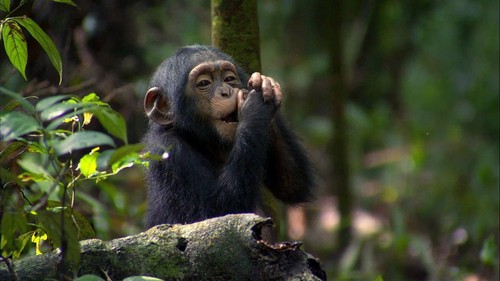 Photo by:
Photo by:
Disneynature takes its sixth documentary deep into the jungles of the Ivory Coast, taking an up-close look at primate species in “Chimpanzee.” Though the story is clearly imposed upon the chimps, and perhaps directed towards Disney’s younger audience, the film has more to offer than just a happy ending.
The film’s plot follows the life of a young chimpanzee, Oscar, growing up with his mother and living with their tribe. Oscar’s tribe finds itself in the midst of a turf war with a rival tribe as both groups of chimps fight for food sources necessary to their survival.
What follows is a tale of love, loss and eventual triumph as Oscar grows and learns, slowly transforming from a nearly outcast child to an accepted member of the close-knit tribe.
This woven tale is narrated by Tim Allen (“Toy Story,” Home Improvement), who does a magnificent job of closing the gap between the audience and the tribe of chimpanzees. Allen’s familiar and calming narration elucidates on much of the physical comedy and intricacies of behavior for the primates, even throwing in a Home Improvement reference for the older viewers.
Perhaps more impressive than Allen, though, is the film’s score. Nicholas Hooper (“Harry Potter and the Order of the Phoenix,” “African Cats”) aids the plot line greatly with his superb orchestral accompaniment. Hooper creates pacing and pathos through his use of either quick-paced or languid string music, helping to bring the animals and setting to life.
“Chimpanzee” delivers outstanding visuals of the dense, wet jungles found in the Ivory Coast. In addition to the scenes of the chimpanzees, the film also makes use of remarkable aerial footage that acts as establishing shots and leaves the viewer in a sense of awe. Nature lovers will fawn over the dense verdurous landscape, the flowing water and the low-hanging clouds.
Disneynature also makes great and effective use of time-lapse footage. In these moments, the audience can see vines growing, spores erupting as rain hits them and luminescent plants fade into the glow of daylight. These scenes are among the most visually stunning in the film.
Cinematography and lighting are outstanding, as is the rest of the photography. As the sun sets on the chimpanzees’ day, or the sun filters through the jungle, light interacts with the setting in a meaningful and beautiful manner.
Together, these aspects of photography make the film and all of its high-definition beauty nothing less than a work of art, enthralling nature enthusiasts and the casual viewer alike.
Some of the difficulties and struggles accompanying the creation of the film are shown during the credits of the film, which introduces the “Chimpanzee” crew. Despite significant trekking through the jungles, enduring pouring rain and some pretty nasty incidents with insects, the crew has managed to create a breathtakingly beautiful film.
With a G rating, the film is clearly directed toward a young audience, as evidenced by the story, which is reminiscent of many classic Disney tales. Yet this film should not be disregarded as a child’s film, or unfit for more mature audiences. As a whole, “Chimpanzee” stands as a serene, informative and captivating nature film with a delightful, if somewhat juvenile accompanying storyline.











